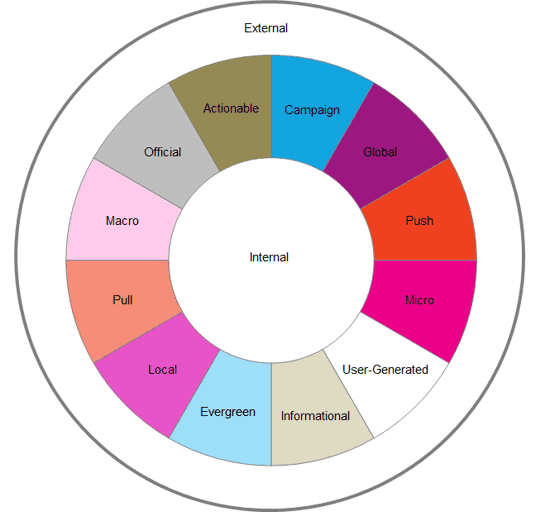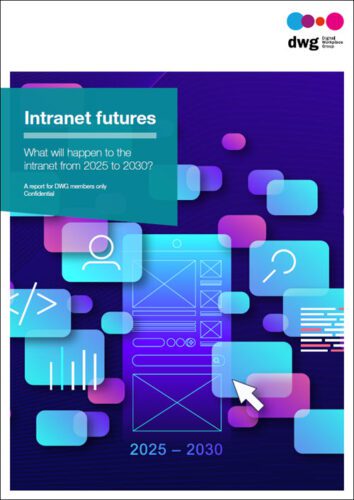Picking the right channel: a guide for internal communications practitioners
Here’s a framework for internal communications practitioners to help them take a more structured and systematic approach to content, audiences and digital channels across the organization.
For Internal Communications (IC) professionals, one of the big puzzles is figuring out the right message for the right audience and the right channel.
This has become even more challenging in recent years with new consumer technologies driving changes in the way employees expect to receive, consume and share information. Whereas before we juggled email, newsletters and intranets, we now have mobile, activity feeds, user-generated content, YouTube, etc. in the mix as well.
Some companies are struggling to stay ahead of this challenge, and making haphazard decisions, resulting in confusing communications and confused employees. Don’t let this happen to you!
Increase your odds
At the Digital Workplace Group (DWG), we’ve developed a framework called the content wheel to help IC practitioners take a more structured and systematic approach to content, messaging and news across the organization.
This framework can help you make more informed and intentional decisions about your content, audience and channels.
Similar to a colour wheel – “ where the complementary colours red and green are opposite one another – the content wheel puts opposing pairs of messages opposite one another, e.g. Push and Pull. For each content “pair” we give a description, examples and recommendations.
Let’s take a walk around the content wheel, looking at the different kinds of content and messages we send on a daily basis in large organizations.

Campaign vs. Evergreen
With the advent of activity feeds, IC professionals have a new opportunity to generate a lot of activity without necessarily generating a lot of new content. Timeless, or evergreen, content can be packaged and repackaged with a new angle or perspective.
Remember that announcement last year about the new social media policy? Post it again, alongside an interview with the Head of Compliance about why it’s so important for the business. Six months down the road, post it again along with a video or quiz. You get the idea.
Campaign-style content, on the other hand, is focused on a specific event, so it isn’t as easy to pull out for slow news weeks. But if the event is annual, such as volunteering day, make sure to recycle as much content as possible. That will not only save you work, but will also reinforce the message – a win-win all around.
Global vs. Local
The late Speaker of the US House of Representatives Tip O’Neill often referred to the advice he had received from his father that “all politics is local”. This same wisdom can be applied to employee communications.
IC professionals know better than anyone that people don’t care about content unless it’s relevant to them; and they’re highly skilled at drawing lines and connecting dots from the global to the local level.
Beyond lines and dots, IC pros also need to find the right balance between truly global and truly local communications. Here are some recommendations to ensure a proper balance:
- Clearly define and communicate criteria for global vs. local messaging.
- Find a good balance of global and local news.
- Clearly label different news categories, e.g. “All company” or “Your location”.
- Ensure better relevancy by personalizing news (by geography, organization and/or role).
Push vs. Pull
Traditionally, IC departments have pushed announcements and have gone to great lengths to target the right content to the right audience, e.g. managers. Of course, this requires “clean” HR data, i.e. up-to-date data that accurately identifies all manager-level employees.
More and more, content is being made available to anyone, and those who are interested can opt in, or subscribe to those announcements. This could be, for example, an American expat on assignment in Switzerland who wants to continue seeing service anniversary updates from her home office in Ohio.
Modern intranet platforms allow people to subscribe to updates on a document, topic, person, group of people, communities, etc. This greatly reduces the data-management burden on IC and HR, and gives people flexibility to stay up to date on their interests, no matter their location or role.
Micro vs. Macro
Micro content refers to headlines, abstracts and summaries. Macro content refers to the full article, policy, report or other content.
Micro and macro content aren’t anything new; we’ve always had headlines, and we’ve always had full articles. But what’s new is the way these content types are being used in the context of new communications technologies and platforms.
Twitter, with its character limit of 140 characters per tweet, challenges the notion that an announcement is only successful if it has a certain number of hits. Perhaps a well-written headline (or tweet) can get the key message across to most people. And those who want more details can click through to the full article.
In a similar vein, mobile phones impose a limitation simply by their size. According to the Pew Research Internet Project, in January 2014, 90% of American adults had a cell phone and 52% of cell phone owners used their phones to send or receive email. Again, employees on the go may only need a strong headline or email subject line; the rest can wait until desk time.
User-Generated vs. Official
In just a few short years, social technologies have become the norm in large enterprises. According to a 2013 McKinsey & Company survey, 83% of respondents say their company is using at least one social technology.
Is the social channel appropriate for your content? That depends on your goal. Use it if you want to invite dialogue and spur action; but think twice about using it just to post information – that might fall flat.
The IC team at a large utility in the United States uses Yammer to cross-promote and drive employees back to the intranet news article. As an example, they ran an article on their Day of Service (a company-wide volunteer event) and, rather than post reminders, they posted messages on Yammer such as: “I’m volunteering for the XXX project! Who’s joining me?”
Internal vs. External
One of the more interesting channel trends is the blurring between internal and external channels. Some content designed for external audiences is now being published on the intranet, while other content that used to be strictly internal is now being published on external channels such as Facebook and Twitter.
Take Genentech for example. Genentech is a biotechnology company in San Francisco with 10,000 employees. They have a YouTube channel, and here they’ve posted a video of employees doing their version of Gangnam style.
Obviously this isn’t your old-style polished corporate video. But it does look like it could be a fun company to work for. Perhaps recruiting had a hand in this? When it comes to creating a company story video for your business, most people decide to turn to professional video production teams to help them produce a video that suits their needs. It could be one that is relatively serious and to the point, or it could be a funny and entertaining one like the video below. However you decide to do it, contacting a production company may be able to help you increase brand awareness and to get the best results as possible.
Actionable vs. Informational
Actionable content implies that an action is required, for example: “Approve timesheets by end of day.” Contrast this to informational or “FYI” types of content; for example, promotions or organizational announcements.
Most IC organizations publish announcements daily, with a mix of actionable and informational announcements in the same stream. The risk is that actionable announcements may get “buried” and won’t get… acted upon.
One way to ensure better compliance with actionable content is to create a separate place for it. At DWG we’ve seen some great examples from our members who have created integrated task lists on their intranet homepages to pull out and highlight this type of critical, time-sensitive, actionable content.
An integrated task list brings notifications and tasks from a variety of enterprise applications into one central dashboard on the intranet homepage. Such a dashboard can present read-only notifications, or offer clickable actions, such as check boxes to note completed tasks, etc.
Full circle
It’s difficult to make smart decisions about content, channels and audiences. It was hard before and now the landscape is even more complex with new communication methods such as mobile, activity feeds, user-generated content, etc.
Make sure you build a structured process for picking the right message for the right audience and the right channel. Map out all your available channels and audiences. And feel free to use the content wheel to talk with your stakeholders about content.
One last thing: if you’re a DWG member, you can download the report on the private DWG member extranet. Featuring case studies from Adobe and Thrivent Financial, this research paper examines some of the digital channels available as part of the communication toolset and also introduces examples of planning tools that will help ensure that channel decisions are made consistently and effectively.
Related research
Digital Communication Channels
 Internal Communications professionals have more choices than ever when it comes to digital channels, including mobile, activity feeds and user-generated content.
Internal Communications professionals have more choices than ever when it comes to digital channels, including mobile, activity feeds and user-generated content.
This research paper examines some of the digital channels available as part of the communication toolset and introduces examples of planning tools that will help ensure that channel decisions are made consistently and effectively for business impact.
See Also
Categorised in: → Internal communications
